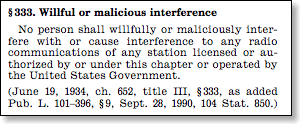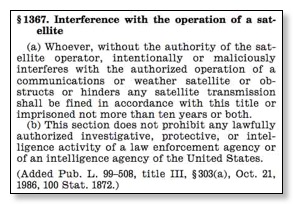NTIA Prison Jamming Report and the Meaning of §333: Why is NTIA So Sure that §333 Restricts FCC but not Them?
[Related NYTimes 1/3/11 article]
About a year ago the conference report on the FY 2010 Consolidated Appropriations Act contained language asking NTIA to study the prison cell phone jamming issue:
“To help State and Federal correctional authorities address this growing national problem, the conferees direct the National Telecommunications and Information Administration at the Department of Commerce, in coordination with the Federal Communications Commission, the Federal Bureau of Prisons and the National Institute of Justice, to develop a plan to investigate and evaluate how wireless jamming, detection and other technologies might be utilized for law enforcement and corrections applications in Federal and State prison facilities. The conferees strongly urge the NTIA, in coordination with the FCC, to investigate and evaluate detection or other technologies that do not pose a risk of negatively affecting commercial wireless and public safety services in areas surrounding prisons” -- H.Rept. 111-366 FY 2010 Consolidated Appropriations Act, Division B -Commerce, Justice, Science, & Related Agencies statement of managers, p. 17-18
As shown at left, the requested report was released December 29.
It appears that the Congress instructed NTIA to “investigate and evaluate how wireless jamming, detection and other technologies might be utilized” in prisons, but NTIA seemed captivated with the idea of parsing §333 for its meaning rather than focusing on the requested technical issues.
Here are some of NTIA’s legal findings in this report that was supposed to focus on technical issues:
- “Jamming interferes with 9-1-1 and authorized calls and violates the Communications Act of 1934 when performed by non-Federal officials.” - p. 1
- “Currently, the operation by non-Federal entities of transmitters designed to jam or block wireless communications violates the Communications Act of 1934, as amended. (The report then cites “47 U.S.C. § 301, 302a, 333. The FCC had reiterated this fact. See Sale or Use of Transmitters Designed to Prevent, Jam or Interfere with Cell Phone Communications is Prohibited in the United States, Public Notice, DA-05-1776, June 27, 2005 ...”) - p. 13
- “The Communications Act of 1934 prohibits non-Federal entities from intentionally interfering with radio signals. Many of the respondents reaffirm this as well. For example, the wireless industry expresses their concerns over deploying a device that violates the Communications Act of 1934.” - p. 16
- “The use of jammers by State or local prison officials is a violation of the Communications Act of 1934, and hence illegal. The FCC has denied previous requests to operate cell phone jammers at State correctional facilities.” - p. 18
- “The use of jammers by State or local prison officials is a violation of the Communications Act of 1934, and hence illegal. Jamming cell signals may be effective where legal in Federal applications ...” - p. 37
- (Jamming is) “Illegal for non-Federal entities; pending legislation for case-by- case jamming” - p. 39
- (Jamming) “Violates the Communications Act of 1934 when performed by non-Federal officials” - p. 40
Despite these repeated statements, even the 2005 public notice does not say FCC lacks the jurisdiction to authorize jamming, but simply FCC hasn’t and therefore it is illegal at present. (“The Communications Act of 1934, as amended, and the FCC rules prohibit the manufacture, importation, marketing, sale or operation of these devices within the United States”). NTIA seems to be trying very hard to espouse the CTIA viewpoint:
“With limited exceptions for certain federal agencies, signal jamming equipment is illegal due to Section 333 of the Communications Act because of those problems.”
So let’s look at this viewpoint. Here is §333:

It was passed in 1990, not 1934, to criminalize certain jamming behavior in cases where the perpetrator had a valid radio license and thus could not be prosecuted under §301 - an example was the 1988 air traffic control jamming of numerous Eastern Airline flights by unionized US Air pilots during a labor dispute. Note that the legislative history of §333 does not mention anything about limiting the jurisdiction of either FCC or NTIA - it focuses on criminalizing unauthorized jamming such as the EAL/USAir jamming.
So why does NTIA and CTIA think it applies to anything FCC might do but has not impact on NTIA? Note that it is in Title III of the Communications Act, not in a law dealing with only FCC. Note that NTIA derives it own authority from this very same Title III: §305 gives the President parallel authority with respect to FCC saying:
Radio stations belonging to and operated by the United States shall not be subject to the provisions of sections 301 and 303 of this title.
Most of the spectrum powers of the Commission come from §303, so clearly federal spectrum users are exempt from such provisions. Note also that §333 is not the only law dealing with jamming. In 1986, only 4 years earlier, Congress passed 18 USC 1367 in the aftermath of the Captain Midnight/HBO satellite jamming incident recently discussed here :

Note the language of 18 USC 1367(b) clearly exempting “any lawfully authorized investigative, protective, or intelligence activity of a law enforcement agency or of an intelligence agency of the United States” from its provisions. No such provision is in §333. So if §333 really means that FCC does not have the jurisdiction to authorize jamming, the obvious implication is that whatever §333 means it applies equally to FCC and NTIA absent any language differentiating them such as contained in §305 or 18 USC 1367.
Furthermore, if the 5 commissioners really felt that they lacked the jurisdiction to authorize jamming, they would have dismissed the petition filed by the South Carolina Department of Corrections and 30 other state correctional agencies in July/August 2009 under the provisions of 47 CFR 1.401(e) rather than letting it gather dust for almost a year and a half. It is truly bizarre that a petition from 30+ state public safety agencies has not been put out for public comment or dismissed after this much time!
But getting back to the technical aspects of the report, NTIA states”
Due to the limited deployment of the jammer transmitter at the Federal facility, NTIA could not draw conclusions from the field measurements assessing the potential of aggregate interference to in-band receivers if multiple jammer transmitters were operated throughout the facility. That is, NTIA could not determine the effects of the jammer on cellular and PCS devices outside the prison facility. - p. 9
Meaning the report is not really very conclusive on a key issue.
Let’s get to the physics of the issue: Both jamming and “managed access” will do their function if their signals are stronger than the signals from the cell site in that area. If in a given location within the prison the managed access or jamming signal is weaker than the cellular signal, then neither can prevent illicit calls by inmates. If at a given accessible by the public location outside the prison the jamming or managed access signal is greater than the carrier’s signal in a given band, then legitimate cell phone calls will be impacted. True in the case of 911 calls they will not be impacted, but all other calls will be impacted unless the cell phones are registered in the managed access system.
This explains the anecdote by FCC’s Adm. Barnett at the 9/30/10 forum on this issue that managed access worked so well at a demonstration that his secretary could not reach him outside the prison. Thus designing an antenna system for distributing the managed access or jamming signal so that it is greater than the cell base station signal everywhere inside the prison and weaker everywhere accessible to the public is an issue common to both systems. Without this careful RF distribution both systems have the potential of spottiness inside the prison and denial of service to the general public outside - although managed access does protect 911 in both cases. It is a problem that is much easier for rural prisons with large buffer areas around them and probably impossible for urban facilities like the Arlington Country Jail which is located in a high rise in an office area. Thus it is odd that Table 7-1 of the NTIA report describes jamming as requiring “(e)xtensive testing prior to implementation” - both system will need comparable testing to verify effectiveness inside prison and lack of impact outside prisons.
The same Table 7-1, on the other hand says about the cost implications of managed access: “Depends on coverage, frequency bands, etc; can be at no-cost to prison authority or vary based on complexity of site; infrastructure costs”. So why is managed access possibly “free”? Most states have contract with high price OSPs (operator service providers) for prison pay phones who charge high rates for inmates’ calls - the original “captive audience”. In the Mississippi test the OSP is paying for he managed access system because it “eliminates competition” resulting in higher revenues although further rate hikes for calls were being considered..
While managed access might appear to NTIA to be “free”, recidivism is a major issue in our prison systems and has a huge impact on society resulting in both high crime rates and high incarceration rates. Indeed, the societal cost of recidivism probably dwarfs the sums involved in this cell phone issue. Studies have shown that increased inmate contact with family can decrease recidivism but inmates and their families and in a poor position to bear the cost of prison payphone calling charges much higher than the rest of the population pays. South Carolina has low calling charges by order of the state legislature where the measure had bipartisan support. The federal Bureau of Prisons also has low calling charges for its inmates. So accounting for the cost of managed access purely by looking at out of pocket costs that are zero because prison OSPs pay for it out of “monopoly rents” is myopic. Indeed, prison OSPs might well want to pay for jamming systems if they were cheaper than managed access and allowed by FCC. (A high FCC official was surprised recently when I mentioned that these prison OSPs were actually subject to FCC Title II regulation and that FCC could reinstate price regulation in this special case where deregulation has failed. Decreasing the exorbitant charges of prison OSPs would probably decrease the illicit cell phone problem since they would then be less attractive to inmates interested in only family contact.)
The real issue here is that the cellular industry is rightly very concerned about jammers in nonprison contexts. There is recurring interest among local law enforcement to use jamming for tactical reasons. Jamming in non-law enforcement contexts is a recurring problem. CTIA’s preferred interpretation of §333 neatly solves both problems. But the continued impasse over prisons is endangering lives. Why can’t we draw a bright line between the prison case where lives are at stake now and these other cases? How many more innocent people have to die before we allow prison authorities the flexibility to protect their staff and the public subject to strict, responsible guidelines that safeguard public communications systems.

Carl Lackl, Jr. (l) a Baltimore witness murdered as a result of a prison cell phone call.
Capt. Robert Johnson (r) South Carolina Department of Corrections, shot 6 times
at his home as a result of a prison cell phone call.




![Validate my RSS feed [Valid RSS]](valid-rss-rogers.png)

